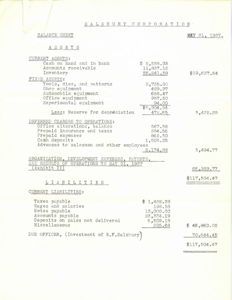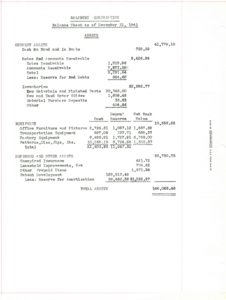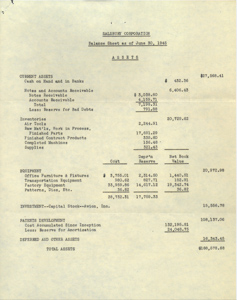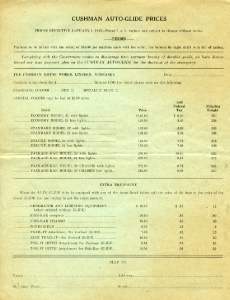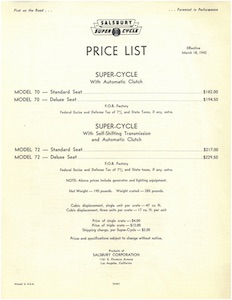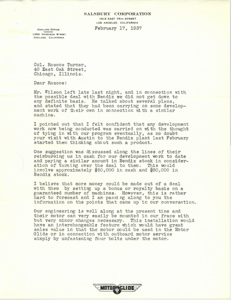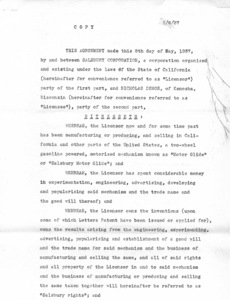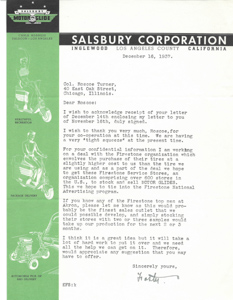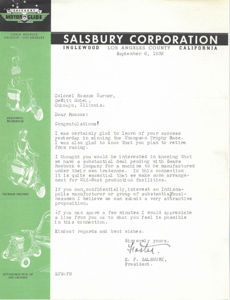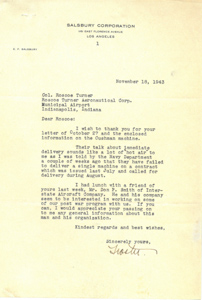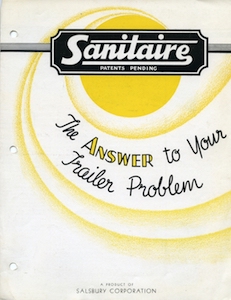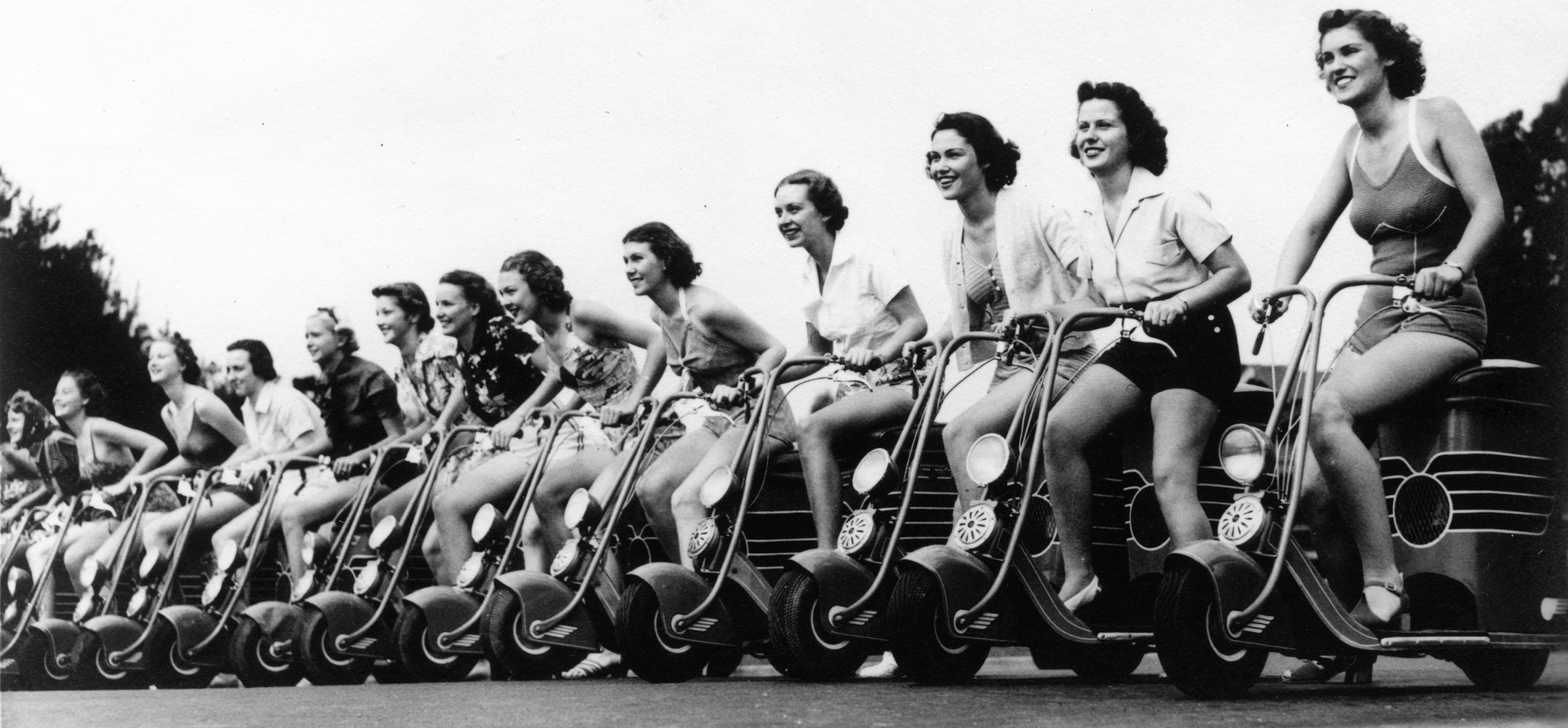
The Salsbury Scooter Business Model - Financial Issues - 1935 Thru 1944
The Salsbury Scooter business was privately owned, so there are no public financial records. Fortunately, Foster sent Roscoe some financial info every now and then, and Roscoe saved almost every scrap of paper he touched apparently. As discussed on the Roscoe Turner page, Roscoe's records are at the University of Wyoming, including his correspondence with Foster over the years. So we have some financial info regarding Foster's Salsbury scooter business.
Foster had many things working in his favor - first to the market with a commercially viable scooter, strong designs with good eye appeal, great innovations like the starting clutch and self shifting transmissions, and wonderful celebrity tie-ins that provided fantastic free publicity. Notwithstanding so many advantages, Foster couldn't turn a profit on the scooter business, and Cushman dominated the scooter business very quickly.
Why was Foster unsuccessful?
Looking thru the available financial info, a couple of things jump out at you. Foster was very undercapitalized (especially by mid-1937), which proved a real handicap. Foster also might have been too focused on innovating the next big thing, rather than churning out what most of the market really wanted - cheap transportation. Finally, Foster probably suffered from a geography problem - his main competitor, Cushman, was centrally located to the biggest part of the country from a scooter sales position (the midwest and east coast, where a good part of the country lived in the 1930s).
The Financial Data
Roscoe's files contained:
According to the 1992 Foster interview that appears in the Salsbury Restorer's Society Newsletter in Vol 62 (2018), Foster sold his shipping business for about $125k in 1933 (which was a very considerable sum at the time). Foster didn't have family money, so the $125k was likely all the money Foster had.
The balance sheet for FYE 1937 indicates that Foster put $70k into the business by May 31, 1937 - an amount 7x greater that what he thought he would have to invest going into the scooter business (according to the cover letter to the balance sheet). Foster thought he had a HUGE hit on his hand, especially with the 1937 Aero, which likely explains why Foster invested so much money in the Motor Glide business. (In a letter to Roscoe in March 1937, Foster says that he could likely sell 5000 to 10,000 1937 Aero's if he could produce them fast enough). With net sales of only $65k by May 31, 1937, however, Foster had only sold about 750 Motor Glides in total from June 1 1936 to May 31 1937. Foster's Motor Glide business lost $67k in the FYE in May 1937.
Foster was essentially out of investable money at this point. In a letter dated October 13, 1937, Foster said that we would discontinue the Motor Glide business immediately unless he received financial help. Roscoe's files do not reflect where the financial help came from, but some help did come as Foster continued in business.
Foster was out of money again by October 1938. In a handwritten note to Roscoe, Foster said that "things are going rather tough these days". In mid-October 1938, Foster was seeking $25k to increase production of Motor Glides and to finance sales of scooters on a time basis to dealer and customers. In a wire to Roscoe dated January 4, 1939, Foster says he is badly in need of $1000. In a letter to Roscoe in later in January 1939, Foster said that he had a tentative commitment for a $25k production loan, but needed to raise another $6k of outside money to obtain the loan. It appears that Foster raised the money finally by pledging all of his stock as security.
The balance sheet from December 1941 shows that Foster never turned a meaningful profit. While Foster's company had $170k of stock outstanding, the company had lost $106k by the end of December 1941.
Thus, it appears that Foster simply didn't have the financial wherewithal starting in mid-1937 to expand his production and sales efforts to any meaningful extent.
Foster Sold Ferrari's - The Public Wanted Chevy's
Foster had a big hit on his hands in 1937 with the Aero. He was basically out of money, but he had the hottest thing going from a design and PR perspective. Instead of focusing on raising money and increasing production for the 1938 model year, however, Foster focused on innovation.
Foster's team of inventors and engineers created the self-shifting transmission in 1938. An internal Salsbury document indicated that Salsbury delayed filling orders while Salsbury was perfecting the self-shifting technology. While the self-shifting transmission was amazing and quite ahead of its time, creating the technology consumed Foster's financial resources and took Foster out of the scooter market for almost a year. This allowed others, most notably Cushman, to jump into the market in a very meaningful way.
Salsbury Motor Glides and Cushman Auto Glides were for the most part very competitively priced. Here is a dealer ad for a 1937 Cushman Auto Glide offered for $125. Basically the same price as a 1937 Aero.
After Foster came out with the self-shifting transmission, the Motor Glide was a flat out better scooter than the Cushman Auto Glide with its clutch and manual transmission. But the Salsbury self-shifting transmission added about $25 to $30 to the price of the scooter. Thus, while Salsbury and Cushman were pricing comparable scooters at the same price, Salsbury added a scooter at a higher price point (with the self shifting technology - the Ferrari of scooters).
Cushman's response to this was brilliant - Cushman created a stripped economy model Auto Glide that allowed Cushman to meaningfully undercut the Motor Glides' price in advertising. Take a look at this 1939 Cushman ad, for example, where Cushman is offering Auto Glides at $112 and up. Salsbury's lowest price offering at that time was $129.50 based on this May 1939 price list. By advertising a much lower price point, Cushman could much more easily lure people into a Cushman dealer, where the dealer might be able to push the buyer into an upgraded scooter.
These two price list from 1942 provide a great way to compare the price points between the Cushman Auto Glides and Salsbury Motor Glides:
Simply put - Cushman advertised its scooters at Chevy prices while Salsbury advertised its Ferrari like Motor Glides with higher price points. The market spoke. Cushman won.
Foster's Geography Problem
This problem is hard to document. But after looking thru Foster's and Roscoe's files and numerous Salsbury and Cushman newspaper articles, we believe that Foster was geographically challenged. Foster undoubtedly got off to a very good start in warm weather spots like California and Florida very early in the game. But as an undercapitalized California based company, Salsbury never created a meaningful dealer network in the midwest and east coast. Salsbury had some good PR in those areas with the Hollywood celebrities and the across the country trip by the two actors in late 1938, but Salsbury didn't convert that PR into a strong dealer network.
Cushman, on the other hand, was a midwest based company. Scooters turned out to be very popular in the midwest and east coast, and Cushman was centrally located to these very big markets for their product. Thus, we suspect Cushman was able to sell a lot more scooters than Salsbury just because Cushman had the biggest markets in its back yard.
Foster's Big Deals - That Didn't Happen
Foster tried his best to land big deals for his Motor Glide business. As his correspondence with Roscoe shows, Foster had numerous Big Deal possibilities, but they all slipped thru his fingers. Any one of these deals could have been a game changer for Foster and Roscoe. The letters discussing the deals are contained below. The letters below are from The Roscoe Turner archives at the American Heritage Center at the University of Wyoming, Roscoe Turner Papers, Collection Number 05267, Box 87.
Big Deal #2 - May 1937. Foster enters into a licensing agreement with Nicholas Demos, with Demos basically acquiring the rights to manufacture and sell Motor Glides in 36 non-western states in exchange for royalty payments of $10k in 1937 and $25k in 1938. Demos didn't make the payments, and never did sell Motor Glides. This prevented Foster from finding a viable east coast partner to make and sell the Motor Glide, however.
©Russ Uzes and Scott Doering/Contact Us
Russ and Scott are always looking for Salsbury Scooters - Motor Glides and Model 85s
We are also looking for Salsbury Scooter historical items - brochures, pictures, service manuals and other memorabilia
